Map of Dien Bien—A Timeless Land of History and Poetic Beauty
More than 70 years ago, the name Dien Bien Phu shone brightly on the world map with the historic victory that was “resounding across five continents, shaking the globe” (May 7, 1954 – May 7, 2025). Today, Dien Bien Province is recognized as a rising tourism hub in the Northwest, with strengths in historical and cultural-spiritual tourism, ecotourism exploring its stunning natural landscapes, as well as leisure, entertainment, and wellness travel.
Geography & Administrative Divisions
Dien Bien is a mountainous province located in Vietnam’s Northwest region. About 450 km from Hanoi, it shares borders with Son La, Lai Chau, as well as China and Laos. Mentioning Dien Bien often evokes memories of a heroic land marked by glorious victories, most proudly the legendary triumph of Dien Bien Phu. Beyond its golden pages of history, this land also captivates visitors with the grandeur of endless mountains, the legendary and rugged Pha Din Pass, and the stunning Muong Thanh Valley, which bursts into vibrant colors every summer. Join Vietnam Original Travel in exploring this once-glorious land through a complete travel guide to Dien Bien below.
Here are some key geographical and administrative facts about Dien Bien:
Total area: approximately 9,540 km²
Population: around 615,000 people
Topography: predominantly mountainous; large intermontane basins such as valleys, rivers, high passes, …
Borders: shares international borders with Laos and China; domestic neighbors Lai Chau and Son La
Region: Northwest Vietnam
Administratively, Dien Bien includes
1 provincial city: Dien Bien Phu (provincial capital)
1 town: Muong Lay
8 districts: Dien Bien, Dien Bien Dong, Muong Ang, Muong Cha, Muong Nhe, Nam Po, Tua Chua, Tuan Giao
Climate & Best Time to Visit
Dien Bien enjoys a cool climate all year round, making it a destination you can visit in any season. However, if you want to capture some of its most distinctive charms, here are a few travel tips to consider:
March: After Tet, every road in Dien Bien is blanketed with the pure white blossoms of the ban flower. This is the perfect time to experience the province’s poetic beauty.
August & September: Dien Bien enters the golden season of ripe rice, with the vast Muong Thanh field turning into a sea of shimmering yellow. You can combine your trip with the rice seasons in Mu Cang Chai or Sapa for an even more exciting journey.
December: Not only Da Lat, but Dien Bien also boasts vibrant wild sunflowers. Traveling along National Highway 6 at this time, you’ll be enchanted by the bright yellow blossoms stretching endlessly along the road.
Travel Tip: If you plan to visit in May, when locals commemorate the Dien Bien Phu Victory, make sure to book your tickets 1–2 months in advance. This period attracts large crowds of tourists who gather to celebrate alongside the local community.
Top Attractions & Natural Wonders
The map of Dien Bien is renowned not only for its glorious victory in history but also for its majestic natural landscapes and diverse cultural identity. Visitors here can explore heroic historical relics, immerse themselves in poetic natural scenery, and experience the cultural beauty of ethnic minorities. Below are some of the most outstanding attractions you should not miss when visiting Dien Bien.
A Brief Look Back: Why the Dien Bien Phu Victory Matters
The Dien Bien Phu Victory was a resounding triumph of the Vietnamese army and people, unfolding over 56 days and nights (from March 13 to May 7, 1954). It marked the peak of the resistance war against the French. At Dien Bien Phu, the Vietnamese forces crushed the strongest French fortified complex in Indochina, annihilating and capturing tens of thousands of enemy troops, shooting down numerous aircraft, and seizing a vast amount of weapons and military equipment. This victory played a decisive role in the success of the Geneva Accords, which ended the war and restored peace in Indochina.
For this reason, the Dien Bien Phu Victory forever stands as a shining symbol of the courage, resilience, intelligence, and creativity of the Vietnamese people. Seventy years have passed, yet the value and significance of this victory remain intact, continuing to inspire and illuminate Vietnam’s revolutionary path today.
Must-See Sites Linked to the Victory
Hill A1
Hill A1 is an important historical relic. It was one of the strongest strongholds of the French garrison at Dien Bien Phu. The hill witnessed fierce battles fought by the Vietnamese army. Today, many historical traces remain on the site, including a system of trenches, craters from explosive charges, and the wreckage of a French tank.
De Castries Bunker
General de Castries’ command bunker was meticulously built by the French in the heart of the Dien Bien Phu stronghold, located on the Muong Thanh field. Situated about 1 km from Hill A1, it was known as the “most solid bunker in Indochina.” Surrounding the bunker was a defensive fence with dense barbed wire and four tanks. Today, the structure and internal layout of the bunker remain intact for visitors to explore. The bunker measures 20 meters long and 8 meters wide, consisting of four compartments that served both as living quarters and a working space for General de Castries and his troops.
Command Headquarters of the Dien Bien Phu Campaign
The Command Headquarters of the Dien Bien Phu Campaign in Muong Phang sits at an altitude of over 1,000 meters above sea level, hidden beneath the canopy of ancient forest. This was the site where General Vo Nguyen Giap and the High Command directly directed the Dien Bien Phu Campaign. The relic area is surrounded by dense primeval forest, creating a quiet and absolutely secure atmosphere. Here, visitors can explore important sites such as General Vo Nguyen Giap’s working bunker, Chief of Staff Hoang Van Thai’s bunker, and the meeting hall.
A1 National Martyrs’ Cemetery
Located on Vo Nguyen Giap Street, just a few hundred meters from Hill A1, this cemetery is the resting place of 644 officers and soldiers who sacrificed their lives in the Dien Bien Phu Campaign. Most of the graves here are unnamed. The cemetery’s solemn design features a 12.5-meter-high memorial monument and hundreds of neatly arranged tombstones, creating a sacred and tranquil atmosphere. Visitors come not only to offer incense and pay tribute but also to honor the noble sacrifices of the soldiers who contributed to the resounding victory that “shook the globe and echoed across five continents” in Vietnam’s history.
Dien Bien Phu Victory Museum
The Dien Bien Phu Victory Museum is located in the center of Dien Bien Phu City. Its unique architecture is inspired by the shape of a pith helmet, with a modern exhibition space divided into five main themes: historical background, campaign preparations, campaign developments, victory, and the impact of the Dien Bien Phu Victory. Visitors can explore more than 1,000 valuable artifacts, photographs, and documents related to the resistance war against French colonialism.
A special highlight of the museum is the panoramic painting featuring over 4,500 characters. Measuring 132 meters in length, 20.5 meters in height, 42 meters in diameter, with 6 meters in relief and a total area of more than 3,200 square meters, it is one of the largest in the world. Painted in oil on canvas from November 2019 and completed in its first phase in May 2021, the work involved around 100 artists. The painting vividly and continuously depicts the key stages of the 1954 Dien Bien Phu Campaign, leaving a powerful and lasting impression on viewers.
Dien Bien Phu Victory Monument
The monument was inaugurated on May 7, 2004, to mark the 50th anniversary of the Dien Bien Phu Victory. It is located on D1 Hill, right in the city center. Standing 12.6 meters tall and cast from 217 tons of bronze, the monument is built on a grand scale. It depicts three soldiers: one holding a rifle, another raising the victory flag high, and the third carrying a Thai ethnic child. With a total height of 16.6 meters and crafted entirely from solid bronze, this is the largest bronze monument in Vietnam.
Scenic Nature & Outdoor Adventures
Beyond its storied battlefields, Dien Bien is a land of sweeping valleys, misty lakes, and sky-high passes. Whether you’re after sunrise viewpoints, island-spotted lakes, or hot springs, these landscapes pair perfectly with a history-themed itinerary.
Muong Thanh Field and Nam Rom River
Muong Thanh Field, known as the “largest rice granary of the Northwest,” stretches more than 20 km along the Dien Bien Valley, covering an area of about 140 km². Surrounded by majestic mountains, the field exudes a peaceful beauty typical of the highlands, especially during the ripe rice season when the entire valley glows golden under the sunlight.
Flowing through the field is the gentle Nam Rom River, which not only supplies water for agricultural production but is also closely tied to the cultural life of the local people. These two landmarks hold not only economic significance but also profound historical value, for it was on the Muong Thanh Field that the Vietnamese army won the decisive victory in the Dien Bien Phu Campaign of 1954.
Muong Nhe and the Westernmost Point—A Pa Chai
Muong Nhe is a border district in the northwest of Dien Bien Province, where the territories of Vietnam, Laos, and China converge. This remote land remains pristine yet captivating, with majestic nature, vast primeval forests, and the rich cultural diversity of ethnic groups such as the Ha Nhi, Hmong, and Thai.
One of the most remarkable destinations in Muong Nhe, highlighted in Dien Bien’s travel guide, is A Pa Chai—the westernmost point of Vietnam, marked by the zero milestone at the tri-border junction of Vietnam, China, and Laos. It is famously known as the place where “a single rooster’s crow can be heard in all three countries.”
The journey to conquer A Pa Chai is challenging, with steep, winding terrain, more than 10 km under the blazing sun and wind, and muddy patches if you go during the rainy season. Yet the tougher the road, the more rewarding the feeling of triumph when you finally touch the westernmost point of the Fatherland.
Pa Khoang Lake
Pa Khoang Lake is a poetic destination nestled amidst the mountains and forests. Covering an area of about 600 hectares, the lake is surrounded by lush primeval forests and villages of the Thai and Hmong ethnic groups. Beyond providing irrigation water for the Muong Thanh field, Pa Khoang Lake is also an ideal ecotourism site. Visitors to Dien Bien can take a boat ride to admire the scenery, go fishing, or simply relax in the peaceful atmosphere, completely detached from the hustle and bustle of daily life. In winter, the lake is often shrouded in mist, creating a magical and dreamy landscape.
Pha Din Pass
For travelers who fall in love with the Northwest and are passionate about conquering challenges, Pha Din Pass is a destination not to be missed. The majestic beauty of mountains and forests, interwoven with the poetic charm of highland villages rich in cultural identity, offers experiences that words can hardly describe when visiting Dien Bien.
At an altitude of more than 1,000 meters above sea level, Pha Din Pass lies on National Highway 6, spanning the border between Son La and Dien Bien provinces. With its rugged terrain and treacherous hairpin bends, this pass is one of the “Four Great Mountain Passes” of Northwest Vietnam, alongside Ma Pi Leng, Khau Pha, and O Quy Ho.
Muong Thanh Field
Nestled in the heart of the Dien Bien basin, the Muong Thanh rice field looks from above like a vast carpet woven from the vibrant green of young rice, which gradually transforms into a brilliant golden hue during the summer days of August. Gazing upon the vast Dien Bien sky under the gentle golden sunlight and breathing in the fragrant scent of freshly ripened rice evokes a lingering, wistful feeling—one that stays with you long after returning to the bustling city.
Muong Lay Town
Located about 100 km from the center of Dien Bien Phu City, Muong Lay stretches along the legendary Da River and is known as the capital of the White Thai ethnic group. The highlight of Muong Lay is the Son La hydropower reservoir—a vast expanse of water surrounded by towering mountains, creating a picturesque landscape reminiscent of an ink-wash painting.
Visitors exploring Dien Bien travel guides will find Muong Lay an inviting stop, where they can enjoy boat rides on the reservoir, experience the graceful Xoe dances of the Thai people, and savor authentic local cuisine.
Pa Thom Cave
Pa Thom Cave is located halfway up a mountain, surrounded by a vast stretch of lush, pristine forest. Inside, the cave remains moist and damp—perfect conditions for the formation of dazzling, otherworldly stalactites and stalagmites. What makes Pa Thom Cave even more intriguing is its connection to local legend. It is said to be tied to the story of a Muong prince, a tale that continues to spark curiosity and draw travelers who come here to explore its mysterious beauty.
U Va Hot Spring
U Va Hot Spring lies amid a pristine mountain landscape, renowned for its natural mineral water source. The water temperature ranges from 76 to 84°C and is rich in minerals beneficial to health. Visitors coming here can indulge in a deeply relaxing soak in the hot mineral waters while also enjoying natural therapeutic treatments that help improve blood circulation, relieve stress, and restore energy. Beyond bathing, travelers can also join in a variety of activities such as playing tennis, cycling, or badminton, and immerse themselves in the cultural performances of the Dao and H’Mong ethnic groups.
Ta Sin Thang Market
Located about 42 km from Tua Chua Town, the Ta Sin Thang market is held once every six days, on the ngo days (horse) and ty days (rat) of the lunar calendar. This vibrant gathering embodies all the cultural essence of a highland market, offering visitors the chance to immerse themselves in the daily life of the mountain people.
As you stroll through the market, take your time to explore stalls filled with colorful brocades handwoven by the skilled hands of the Hmong, sip a cup of fragrant Mong Pe corn wine, and let yourself be carried away by the soulful melodies of the khen (traditional Hmong bamboo flute).
Cuisine & Local Specialties
Besides majestic natural landscapes and historic sites that preserve the heroic wartime memories of the nation, Dien Bien also captivates visitors with its unique local specialties. Be sure to note down these delightful dishes as travel tips for your journey to Dien Bien!
Grilled Chicken with Mac Khen
Mac Khen is a distinctive spice found in the mountains of Northwest Vietnam. To prepare this dish, chicken is grilled over charcoal with a moderate flame. There is no need to brush oil on the chicken while grilling, as its natural fat slowly melts and keeps the meat moist. Once the chicken becomes firm and golden, a layer of Mac Khen seasoning is brushed onto the skin, giving the dish its rich flavor and signature aroma.
Pa Pinh Top (Thai-style Grilled Fish)
At first, the name may sound unusual, but this is the local term for a traditional grilled fish dish from Dien Bien. Pa Pinh Top is considered a precious delicacy, deeply valued in the culinary heritage of the Thai ethnic group in Northwest Vietnam. The main ingredients are freshwater fish such as carp, grass carp, or black carp. After cleaning, the fish is cut open along the backbone, making it easier to flip during grilling. A mixture of spices is stuffed inside the fish’s belly, allowing the flavors to seep into the flesh and create a savory, irresistible taste.
Nep Nuong Sticky Rice
Nep Nuong is a famous variety of sticky rice in Vietnam’s Northwest, but the finest is found in Dien Bien. The grains here are plump, naturally sweet, fragrant, and more tender compared to other types. Preparing a perfect pot of nep nuong sticky rice requires patience and meticulous care to ensure the rice is evenly cooked, soft, and aromatic. It is best enjoyed with a sprinkle of sesame salt or paired with savory dishes.
Chit Worms
Chi worms are larvae that live for years inside the stems of the chít plant and are considered a highly nutritious delicacy. These plump, milky-white worms are often collected and soaked in liquor, a method that helps preserve their nutrients without degradation. Besides soaking in alcohol, sâu chít can also be dried or cooked into various delicious and nourishing dishes.
Canh Bon (Thai-style Soup with Buffalo/Cow Skin)
The last dish on this list is Canh Bon, a rustic specialty of the Thai ethnic community. This unique soup is made from buffalo or cow skin, combined with bon stems (a type of wild taro), wild eggplants, aromatic herbs, and various spices. When tasting it, you’ll discover its distinctive character: the chewy, crunchy texture of buffalo or cow skin blends with the slight bitterness of the eggplants, the fragrant zing of mac khen (a local pepper), and the warmth of lemongrass—together creating a one-of-a-kind flavor found nowhere else.
Ethnic Diversity In Dien Bien
Dien Bien is home to 21 ethnic groups living together. Each group has its own unique language, customs, and cultural traditions, creating a colorful mosaic that enriches the province’s cultural identity. Below are some highlights about several of the major ethnic groups in Dien Bien.
The Thai People
The Thai have lived in the Northwest for more than ten centuries. In Dien Bien, they make up the largest ethnic group, accounting for 38.4% of the province’s population.
Thai women wear distinctive attire, including a close-fitting com blouse fastened with silver butterfly buttons, a long ankle-length skirt, and a pieu headscarf, creating a graceful and elegant look. Their most famous handicrafts are brocade fabrics with unique, colorful patterns and durable reed-stuffed quilts. The Thai live in stilt houses, and each village typically has 30–80 houses clustered along streams and water sources.
The Hmong People
The Hmong are one of the three largest ethnic groups in Dien Bien’s 21, making up 29.6% of the population. Their main livelihood comes from slash-and-burn farming, especially growing corn and rice. They often reside in high mountainous areas and are known as skillful blacksmiths and metalworkers.
Hmong culture is rich and diverse, particularly visible during New Year celebrations with activities like pao throwing and khen dancing. Interestingly, the Hmong celebrate their New Year earlier than the traditional Lunar New Year. During these festive days, villagers gather in open spaces to sing, dance, and enjoy community activities.
The Ha Nhi People
The Ha Nhi live mainly on upland farming, though some areas cultivate wet rice, and livestock raising is also well developed. Their houses are mostly built from earth with thatched roofs—low and small, making the interiors often dark. Their clothing is distinctive: at first glance resembling long tunics of the Kinh people, but decorated with two strips of alternating red and yellow fabric sewn in 36 layers. The collar is adorned with silver coins, while their vibrant headscarves are decorated with bead chains hanging down, and women often wear numerous silver bracelets.
The Lu People
The Lu have a long tradition of rice cultivation, with every household maintaining a garden next to their home. They prefer sticky rice to regular rice, enjoy chili, drink tea, and men often smoke thuoc lao (strong pipe tobacco). Their clothing is richly decorated, with colorful motifs on indigo-dyed fabric—whether it is men’s trousers or women’s skirts, blouses, and scarves.
Festivals in Dien Bien
Dien Bien is not only famous for the historic Dien Bien Phu victory but also a land rich in cultural festivals. These festivals not only reflect the spiritual and cultural life of the communities but also offer visitors the chance to explore the history, traditions, and unique identity of local ethnic groups. Here are some of the most remarkable festivals you shouldn’t miss when visiting Điện Biên.
Dien Bien Phu Victory Anniversary
Every year on May 7, Dien Bien holds the Victory Anniversary to commemorate the resounding triumph of the Vietnamese people at Dien Bien Phu.
The celebration is not only a time to honor the heroes who sacrificed their lives but also an opportunity for younger generations to better understand the glorious history of the nation. Activities include parades, exhibitions, and artistic performances that reenact the heroic atmosphere of the battle, attracting large numbers of visitors.
The Hoa Ban Festival
The Hoa Ban Festival is a unique and long-standing cultural tradition of the people of Điện Biên. Every year, in the second lunar month, when spring arrives and the forests are covered in the white blossoms of the hoa ban (Bauhinia flowers), the Thai people of the Northwest hold the festival to pray for good harvests, express filial piety to their ancestors, and provide a chance for young men and women to meet through songs and dances.
Known as a festival of love and happiness, the Hoa Ban Festival symbolizes life, vitality, and the resilient spirit of Dien Bien’s people.
The Kho Mu Rain-Praying Festival
The Kho Mu people have a traditional festival to welcome the first rains of the season, which bring fertility and prosperity to their fields. This festival, called om din om dang (meaning “celebration of water”), is held around late March to early April of the lunar calendar, depending on the weather. It usually takes place in stilt houses, with the participation of the entire community.
The Tua Chua Buffalo Fighting Festival
The Buffalo Fighting Festival in Tua Chua District is one of the most distinctive events of Dien Bien, often held at the beginning of the year. It draws huge attention from locals and tourists alike.
Besides being a form of entertainment and a way to pray for peace and prosperity in the new year, the festival also serves as an opportunity to promote and showcase the unique cultural traditions of the local people.
How To Get To and Around Dien Bien
Getting to Dien Bien
There are various means of transportation to Điện Biên depending on each traveler’s needs, preferences, and budget:
By Airplane: Currently, there are three flight routes to Điện Biên Airport: Hanoi–Dien Bien, Ho Chi Minh City–Dien Bien, and Hai Phong–Dien Bien. Popular airlines include Vietnam Airlines and Vietjet Air.
By Car (Self-Drive): From downtown Hanoi to Dien Bien is about 450 km. You can follow routes DT87, QL32, and QL37 via Hoa Binh and Son La.
By Sleeper Bus: Many long-distance sleeper bus lines operate routes to Dien Bien, such as Hai Van, Hoang Long, Phuong Trang, and Tien Oanh.
By Motorbike: For those who love scenic and adventurous journeys, riding a motorbike from Hanoi to Dien Bien (around 500 km) is an option. This trip typically takes a full day of travel.
Getting Around Dien Bien
Private Car: If you have a personal car, this is the most convenient way to explore Dien Bien and its surrounding attractions. Roads are fairly accessible, allowing easy travel between Dien Bien Phu city and nearby destinations.
Motorbike: Renting or riding your own motorbike is also a popular choice for getting around. This is especially suitable for exploring rural areas or places that are harder to reach by car.
Where to Stay in Dien Bien
Dien Bien has a well-developed tourism industry, so lodging services here are quite diverse—from guesthouses and hotels to homestays and cultural villages. Below are some popular accommodation options you can consider for your Dien Bien travel experience.
Notable Hotels in Dien Bien
Overall, accommodation prices in Dien Bien vary. For budget-conscious travelers, guesthouses cost around 300,000 VND per night. If you’re looking for something more upscale, here are some of the most popular hotels:
Muong Thanh Holiday Dien Bien Phu
Address: 514, 7/5 Street, Him Lam Ward, Dien Bien Phu City
Room rates: From 1,600,000 VND/room/night
A great option for those who enjoy comfort and luxury, part of the well-known Muong Thanh hotel chain across Vietnam.
Him Lam Resort
Address: Group 6, Him Lam, Dien Bien Phu City
Room rates: From 700,000 VND/room/night
Phadin Hotel – Military Zone 2
Address: 63, Thanh Bình Ward, Dien Bien Phu City
Room rates: From 400,000 VND/room/night
Immersive Stays in Cultural Villages
If you prefer an authentic experience close to nature and want to live like the locals, cultural villages are an excellent choice. Here, you can enjoy traditional architecture, community activities, and warm hospitality.
Co My Cultural Village
Address: Thanh Chan Commune, Dien Bien District
Contact: Mr. Phuong (Village Head)—0230.3953968/0943.835577
Men Cultural Village
Address: Thanh Nua Commune, Dien Bien District
Contact: Mr. Nhot – 0230.3831522
Ten Cultural Village
Address: Thanh Xuong Commune, Dien Bien District
Contact: Mr. Un (Village Head)—0230.3953968
Map of Dien Bien—Ready for Your Dien Bien Adventure
Summer is just around the corner, and the heat is rising—what could be better than an escape to the highlands to enjoy the refreshing coolness of the mountains? Hopefully, these Dien Bien travel tips will help you “pocket” plenty of useful advice for your upcoming journey. If you’re planning a trip to Điện Biên or the Northwest, don’t hesitate to contact Vietnam Original Travel for more detailed advice on self-guided itineraries as well as organized Dien Bien and Northwest tours!
>>> Map of Lai Chau: The Hidden Gem of Northwest Vietnam
>>> Ultra Travel Guide of Son La Vietnam
Send us your comments about : Map of Dien Bien—A Timeless Land of History and Poetic Beauty
Required fields *
You might also be interested
Travel ideas
Need some inspiration? Discover some of the best tours in Vietnam, which are highly appreciated by our clients. An excellent starting point to help you choose the right trip to Vietnam, Laos, Cambodia, Burma or Thailand, whether you are traveling alone, as a couple, as a family or with friends.
And because this trip is yours, feel free to customize it as you wish!
Vietnam Cambodia Itinerary 14 Days
Hanoi – Hoa Binh – Mai Chau – Ninh Binh – Halong bay – Hue - Danang – Hoian – Saigon – Ben Tre - Can Tho – Saigon - Siem Reap Angkor - Tonlé Sap - Siem Reap – Ta Prohm - Departure
Vietnam 14 Day Itinerary
Vietnam 14-day itinerary covers the country’s top highlights and quintessential experiences for an unforgettable journey.
Honeymoon Tour Packages In Vietnam 12 Days
Saigon Arrival - City Tour – Mekong Delta – Danang – Hoian - by flight - Da Nang – Hanoi - by flight – Halong - overnight on junk – Departure
Authentic Hoang Su Phi Trekking Tours
Hoang Su Phi trekking tours take you to stunning terraces, meet few tourists, connect with locals and enjoy authentic culture.
Best Nha Trang Beach Tour 4 Days
Saigon/Hanoi – Nha Trang relaxation – Saigon/Hanoi – Departure
Mekong Delta Bike Tour Itinerary 7 Days
Cycle through the Mekong Delta in 7 days, discovering floating markets, orchards, craft villages, and tranquil green islands.
Are you interested in this tour?




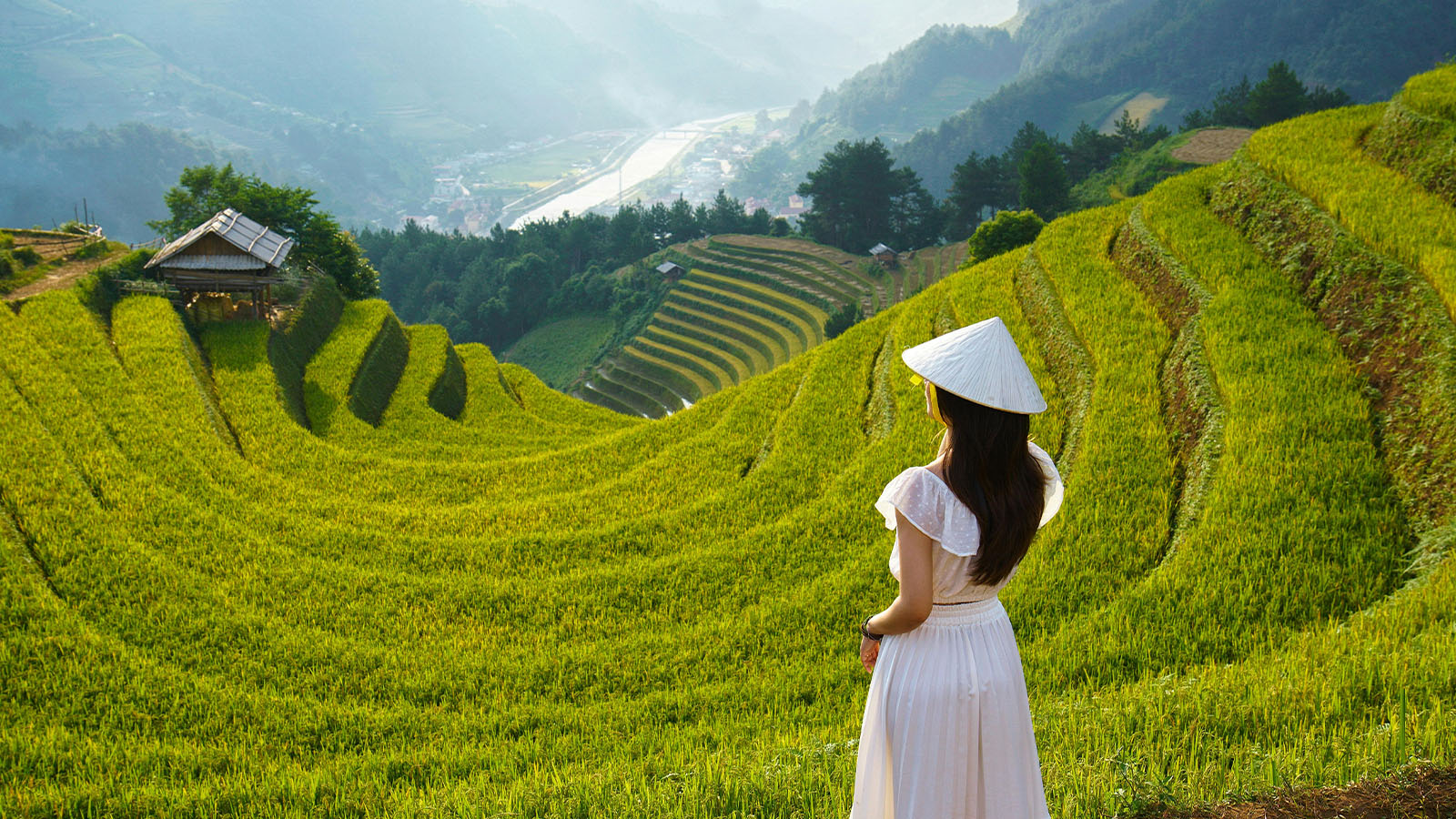





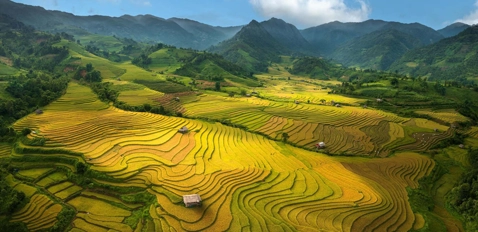






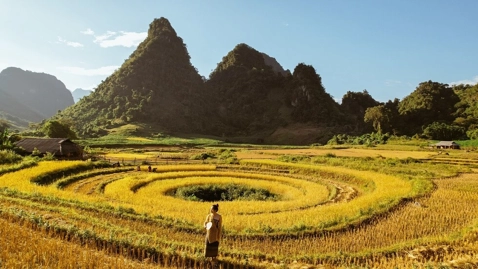

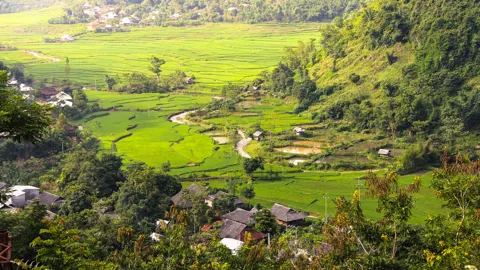


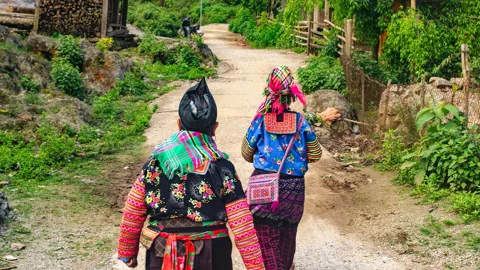
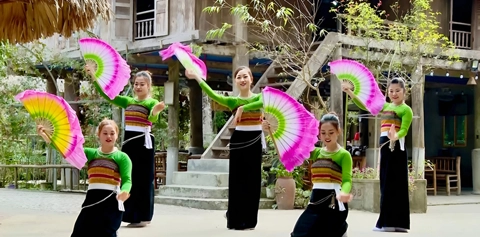














Comment